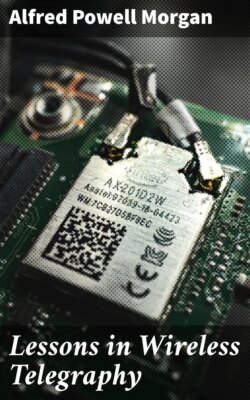Читать книгу Lessons in Wireless Telegraphy - Alfred Powell Morgan - Страница 5
На сайте Литреса книга снята с продажи.
LESSON TWO. MAGNETIC INDUCTION.
ОглавлениеTable of Contents
In 1831 Michael Faraday, the great physicist, made the valuable discovery that electric currents are induced in a closed circuit by moving a magnet near it or vice versa, by moving the circuit across the field of force, If a coil of insulated wire be connected in circuit with a sufficiently delicate galvanometer (a galvanometer is an instrument for detecting feeble electric currents) and a bar magnet suddenly plunged into the hollow of the coil as shown in the illustration, a momentary current will be indicated as flowing through the galvanometer while the magnet is being moved in the coil. If the magnet is then rapidly pulled out of the coil another momentary current will be observed to flow in the opposite direction from the former.
FIG. 5. Magnetic Induction.
So long as the magnet lies motionless in the coil it induces no currents. The field of force in the neighborhood of a magnet grows weaker as the distance from the magnet increases. When the magnet is plunged into the coil, the strength of the magnetic field in the vicinity of the coil grows stronger due to the approach of the magnet, and when it is withdrawn the field becomes weaker.
Currents are only induced in the coil when the magnet is moving, or in other words when the strength of the magnetic field is changing, either increasing or decreasing.
The currents generated in the coil are called induced currents. The action of the magnetic field in producing induced currents is termed Induction.
